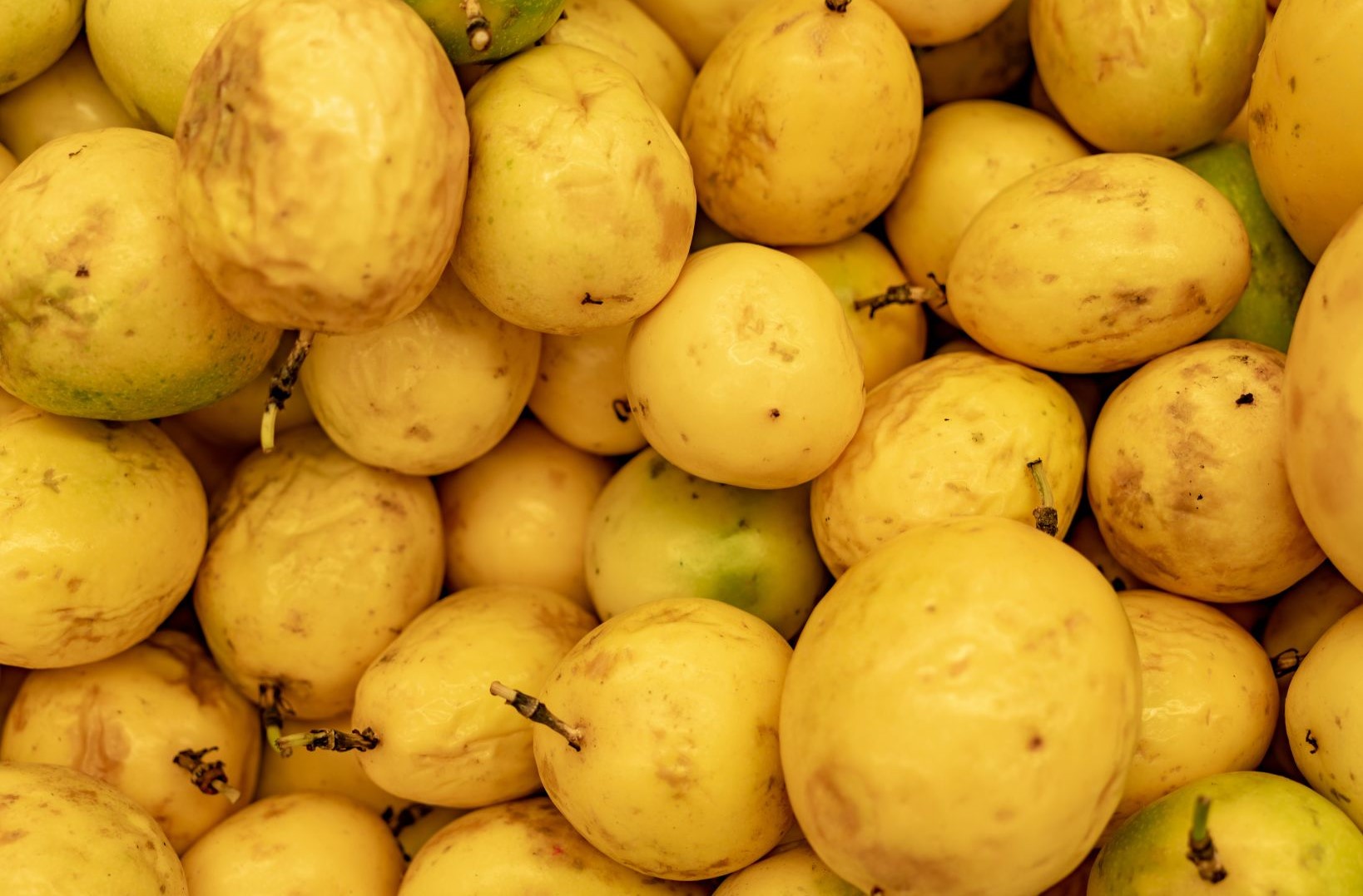Important Passion Fruit Diseases
What are passion fruit’s major diseases, and how can they be controlled? – Passion Fruit Plant Protection
Anthracnose (Colletotrichum gloeosporioides)
Frequently occurs following mechanical wounding of the plant, which provides the pathogen an entry point. Shoots may start dying back from the tips; the leaves shrivel and die but usually remain attached to the shoot. Blackening of the middle part of the stem (usually starting from the point of infection) may be observed. Because the fungus moves towards the base of the plant, its impact can be reduced if infected parts are pruned back, starting at least 10 cm below the visibly affected part, and the material is discarded either by burring deep or burning. Avoiding wounding of the plant will greatly reduce the likelihood of infection, along with good field hygiene practices.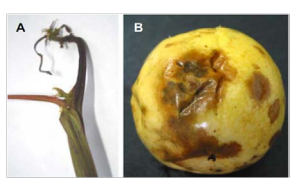
(A) Death of Passion fruit shoots affected by anthracnose, (B) Fruit Rot due to anthracnose (Joy et al.,2012)
Bacterial Grease Spot (Pseudomonas syringae pv. passiflorae)
This is caused by the bacterium Pseudomonas syringae pv. passiflorae and is one of the most severe diseases of passion fruit. It infects leaves, stems, and fruit, leading to severe crop losses and even death of vines. It causes irregular greenish-to-brown lesions on leaves, often surrounded by a light-yellow halo. If unchecked can result in severe defoliation. This disease affects under-ripe fruits. The first signs of infection on the stems of young growth are small, slightly sunken, dark-green, water-soaked spots. These develop into light-brown, markedly depressed areas. On older wood, symptoms range from small, somewhat sunken, smooth, dark-green circular spots to large, dark-brown, cracked lesions, which may completely girdle shoots and kill vines. Small, dark-green, oily spots are early signs of infection on the fruit. These develop into roughly circular, greasy, or water-soaked patches—premature fruit drop and fruit decay result.
Brown Spot
This fungal disease, caused by Alternaria passiflorae and A. alternata, is a significant concern as it affects multiple parts of the passion fruit plant, including leaves, stems, and fruit. Symptoms initially manifest as small brown spots on the leaves, gradually enlarging and developing a lighter-colored central area, resulting in irregular or angular shapes. On the stems, elongated dark-brown lesions typically occur near leaf axils or where the stems come into contact with support structures like wires. The infection spreads from these points, and when the stem is completely encircled, the affected shoot suddenly wilts, leading to fruit collapse.
This disease poses a significant threat to passion fruit crops and requires appropriate management strategies to minimize its impact. The disease begins on the fruit with tiny pinprick-sized spots that progressively grow into sunken circular lesions with brownish centers. Over time, the rind surrounding the affected area becomes wrinkled, and the fruits shrivel and eventually drop from the plant.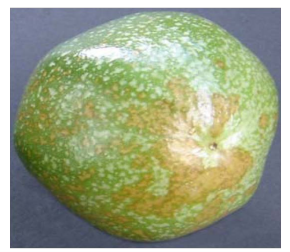
Passion fruit affected with brown spot disease (Joy et al.,2012)
Passion Fruit Phytophthora Root and Crown Rot
It is a prevalent disease that affects passion fruit plants. Various pathogens, including species of the fungal genus Phytophthora, cause it. More specifically, commonly found pathogens are Phytophthora cinnamomi and Phytophthora nicotianae. The fungi can cause the death of vines, but it is thought that the stress and damage they often cause open the way for invasion by Fusarium and the death of the plant from crown canker. Phytophthora root and crown rot disease can impact both mature plants and plants in the nursery stage. The disease initially presents as mild chlorosis, a condition characterized by yellowing the leaves. As the infection progresses, wilting, defoliation, and, ultimately, plant death occurs. The disease initially appears in specific locations and can spread from one plant to another. It is more prevalent in clay soils during periods of rain when temperatures range between 26°C and 30°C (68 and 86 °F). The optimal temperature for growth is 37°C (99 °F). Improving drainage is a way to reduce the risk of Phytophthora infection.

Crown Rot of Passion fruit caused by Phytophthora nicotianae. (Joy et al.,2012)
Crown Canker of passion fruit
This is a lethal condition of passion fruit, causing sudden wilting, leaf and fruit drop, and death. It has been a major factor in limiting the commercial production of passion fruit.
A number of Fusarium species have been isolated from plants suffering from crown canker.
The condition usually occurs close to ground level, on wounds caused by growth cracks, mechanical damage, fertilizer or herbicide burn, or by pest injury such as that caused by slugs or snails. Crown canker primarily affects the lower part of the passion fruit plant, near the soil line or crown area. Infected plants display dark, sunken lesions or cankers on the crown or lower stem. These lesions may be discolored, exhibiting a brown or black appearance. As the disease progresses, infected plants often experience wilting of leaves and a general decline in vigor. The wilting may initially occur in isolated branches but can spread to the entire plant over time. Infected stems and branches may develop cracks in the bark, especially near the cankered areas. This can expose the underlying wood and contribute to the spread of the disease. In severe cases, crown canker can lead to the death of the entire passion fruit plant. The combination of decay, wilting, and decline weakens the plant’s ability to sustain itself, ultimately resulting in its demise.
Unfortunately, there is no known control for crown canker, so all efforts to reduce the risk of infection are worthwhile. These would include a selection of the best sites to minimize weather damage, regular frost protection with bracken fern or similar material each winter, and avoiding injury to the base of the plant by implements, fertilizer, or herbicides.
It is also good practice to keep the base of the plant clear of grass and weeds, which favor fungal growth, and harbor slugs and snails. Where collars are placed around stems to protect against herbicide damage, slug pellets placed inside the collar will help control these pests. Plants suffering from crown canker should be carefully removed and destroyed by burning.
Sclerotinia rot (Sclerotinia sclerotiorum)
Sclerotinia sclerotiorum is a fungal pathogen that can affect passion fruit plants, causing a disease known as Sclerotinia rot. This fungus is known to have a wide host range and can infect various crops, including passion fruit.
The fungus produces a white, cottony mycelium that covers the affected plant parts, such as stems, leaves, and fruit. This fluffy growth is a characteristic feature of Sclerotinia rot. Infected plant tissues develop water-soaked lesions that eventually become necrotic (turn brown or black). Infection occurs mainly in the period when vines are wet for 16-24 hours, and temperatures are in the 15 to 20◦ C range. These lesions can appear on leaves, stems, flowers, and fruit. The affected plant tissues become soft and mushy, leading to the decay of leaves, stems, and fruit. The affected fruit may collapse in advanced stages and become covered with white fungal mycelium. Sclerotinia sclerotiorum produces small, dark, and hard structures called sclerotia. These sclerotia can be found within the infected tissues, on the soil surface, or in plant debris. They play a significant role in the survival and spread of the fungus.
Sclerotinia rot is favored by cool and moist conditions, especially during flowering and fruiting stages. It spreads through spores produced by the fungus, which can be dispersed by wind, water, or movement of contaminated equipment or personnel. The disease can be introduced into a passion fruit plantation through infected plant material or soilborne sclerotia.
Management of Sclerotinia rot in passion fruit includes several strategies such as sanitation, crop rotation, fungicide applications and resistant varieties
Early detection, regular monitoring, and prompt management strategies are essential for minimizing the impact of Sclerotinia sclerotiorum on passion fruit plants and preventing its spread within the plantation.
Septoria blotch (spot)
Three species of Septoria cause can cause the spot disease. Septoria fructigena, S. passifloricola and S. passiflorae. Among them, S. passifloricola seems to be more widely spread. The fungal disease affects passion fruit plants’ leaves, stems, and fruit. It is a common disease found in passion fruit growing areas. The pathogen attacks both the leaves and fruit, forming small brown spots on the leaves and stems. These spots can merge, covering large areas of the fruit. Infected fruit may ripen unevenly or even rot completely, negatively impacting juice quality during processing. Even a mild infection can cause significant leaf and fruit drop, resulting in defoliation and premature fruit loss. The disease manifests on the leaves as tiny, irregular, light-brown spots, quickly leading to severe defoliation as the infection spreads. Similar spots also appear on the stems, becoming deeply sunken but remaining small. The initial infection appears on the fruit as small spots resembling those on the leaves and stems. These spots develop into extensive superficial lesions, causing premature fruit drop and decay. Like many fungal diseases, thrives in environments with high humidity. Therefore, it is more likely to occur when plants are not adequately pruned and trellised. The disease can be transmitted through infected seeds, and the use of leftover seeds from fruit processing factories or consumption has facilitated its spread. The disease starts early in the plant’s life through seed transmission and rapidly spreads in the nursery due to water-borne dispersal. The optimum conditions for the growth of fungus are temperatures ranging from 5◦ to 35◦ C (42-95 °F). The lack of inspection and removal of infected seedlings contributes to the disease’s propagation. As a result, some plantations experience high levels of infection. The use of fungicides has been limited since there is currently only one registered for passion fruit in the region. Prevention is the most effective approach for controlling Septoria passiflorae. It involves carefully selecting fruit from which seeds are extracted for seedling production and implementing thorough inspection and maintaining hygiene practices at the nursery and field levels.
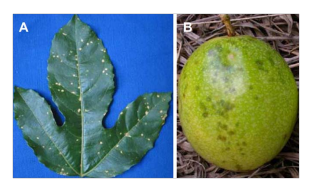
Septoria blotch symptoms on passion fruit (A) Leaf (B) Fruit (Joy et al.,2012)
Scab
It is also known as Cladosporium rot and the responsible pathogen is Cladosporium oxysporum.
Plants infected with Cladosporium exhibit small circular spots on their leaves. Initially, these spots are translucent and later turn necrotic, with greenish-grey centers where the fungus produces its fruiting structures. These lesions can penetrate the leaves, affecting veins and causing deformations that may lead to leaf drop. Similar spots can also appear on bud sepals or open flowers. If numerous lesions develop on flower buds or peduncles, it can significantly reduce the number of viable buds. On twigs and twig tips, initial lesions resemble those found on leaves. Still, they later develop into elongated and sunken cankers with a greenish-grey appearance where the fungus produces its fruiting structures. As scar tissue forms, the affected branches become weakened and prone to breaking in the wind. On small fruits, symptoms manifest as slightly sunken spots with small dark circular lesions. On larger fruits, the lesions on the skin become cork-like, prominent, and brownish. However, these lesions do not penetrate the inner fruit and therefore do not affect the quality of the juice. Multiple lesions on the same fruit can cause deformations and stunted growth. The disease primarily affects young tissues such as leaves, branches, tendrils, flower buds, and fruits. When not properly controlled, it can cause significant damage. In field conditions, it can result in twig death, delay flowering, and reduce the commercial quality of the fruit.
Scab Symptoms on Passion fruit (A) Leaf (B) Fruit (Joy et al.,2012)
Thielaviopsis Root Rot in passion fruit
This is another fungous disease that can affect passion fruit growing on heavy soils. It is caused by Thielaviopsis basicola. Infected plants are unthrifty, with poor-colored foliage. The roots show signs of decay and are often blackened.
Control: With mild infections, sometimes a severe pruning to balance the top growth with the loss of roots can keep the plants going, but severely infected plants should be removed and replaced.
Collar Rot in passion fruit
Responsible pathogens for this disease are homothallic strains of Haematonectria haematococca and Fusarium solani. The initial visible symptom is a slight decline in the plant’s above-ground growth, followed by a change in leaf color to a pale green shade. Subsequently, wilting and loss of leaves occur, ultimately leading to the death of the plant due to complete necrosis encircling the plant’s collar. The necrosis typically extends 2 to 10 cm above the ground and can also spread to the roots. Swelling and cracks in the affected bark of the collar exhibit purple lesion borders, with reddish structures becoming visible under conditions of high relative humidity. Generally, the disease affects plants within one to two years of planting, although it can occur earlier in areas where the pathogen has previously been present.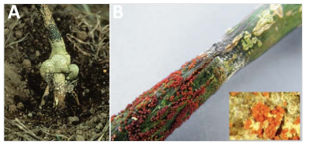
(A)The swelling at the base of the vine is caused by Fusarium solani (B) Base rot on passion fruit showing white mycelium and crimson perithecia of Haematonectria haematococca (Joy et al.,2012)
The woodiness of Passion fruit
Responsible pathogens are Passion fruit woodiness virus (PWV), cucumber woody virus (CWV), and alfalfa mosaic virus, or a combination of these or possibly other viruses as well.
The main symptom of this severe viral disease is the thickening and hardening of the fruit skin, resulting in smaller fruit size and a significant reduction in juice content. The foliage often displays a yellow mosaic pattern and exhibits crinkling. The infected plants experience stunted growth, and depending on the timing of the infection, they may fail to produce any marketable fruit. The virus can be found in plants belonging to the Cucurbitaceae family, bananas, and various weeds. It is transmitted by insects, particularly aphids, as well as through mechanical means such as contaminated field tools. Infected plants may not exhibit symptoms as long as they are not subjected to stress. However, when growing conditions become sub-optimal due to factors like drought, nutrient deficiency, or cool temperatures, the virus becomes active, and the only solution is to remove and destroy the affected plants. In Kenya, this virus has severely impacted passion fruit plantations, leading some growers to abandon passion fruit production. The disease manifests on leaves as yellow spots, flecks, or mottling, accompanied by crinkling and distortion. Stems exhibit shortened internodes, clustering of foliage, and stunted growth. On fruit, the virus causes the development of thick, hard, and distorted woody rinds, often displaying characteristic scabs and cracks and resulting in significantly reduced pulp yields.
Control measures include planting only virus-free plants and removing and replacing severely infected vines. Aphids transmit the disease, and it is advisable to control aphid populations diligently. Once the vines become infected, there is currently no known control method. Infected plants should be identified and removed from the plantation. Minimizing virus symptoms can be achieved by promoting vigorous vine growth. If necessary, disinfect pruning tools between vines or different parts of the plantation using a 1% solution of hypochlorite (bleach), followed by neutralization in vinegar and proper tool protection. It is important to note that there are currently no varieties of passion fruit resistant to this virus. Therefore, the focus should be on preventing plant infection and the development of virus symptoms. If preventive measures fail, the only option is to uproot and destroy all plants showing signs of this disease.
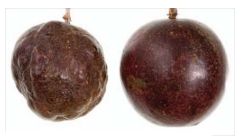
Passion fruit woodiness disease (Joy et al.,2012)

Crinkled leaf symptoms of woodiness virus disease. (B) Molting of passion fruit leaves caused by CWV (Joy et al.,2012)
Mosaic Disease of Passion Fruit
Cucumber Mosaic Virus (CMV)
This virus has a less devastating effect on passion fruit plants than PWV, and is not very widespread. Infected plants usually have distorted leaf and shoot growth, especially in the youngest leaves/shoots. Leaves and fruit often develop ring spots (a pronounced yellow color in leaves, green to greenish yellow as fruits ripen). This virus is spread by insects (aphids) and mechanical means; it may also be seed-transmitted.
Since CMV has an enormous host range (over 1,200 plant species, including many common vegetables as well as weeds), it is difficult to control once it has been introduced into an area. Infected plants should be uprooted and destroyed as soon as they show disease symptoms. As with PWV, prevention is the key to managing this virus, starting with careful seed selection and good hygiene at the nursery and field levels.
Passion fruit yellow mosaic virus (PaYMV)
Infected plants have a bright yellow mosaic, yellow net, and leaf crinkles. The virus can be transmitted mainly through a polyphagous beetle, Diabrotics speciosa, which can occasionally be found in passion fruit. Any vines whose leaves show mosaic or vein-clearing symptoms should be removed and destroyed. Vines may show cankers or stem lesions near the soil line and slowly decline after growing for as long as 5-7 years. When this happens, it is advisable to start new vines for replacements, preferably in a new site.
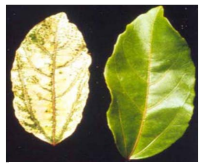
Symptoms of passion fruit Yellow Mosaic Virus on affected leaf and healthy leaf (Joy et al.,2012)
Pests & Diseases IPM Strategies
Diseases in fruit production can stem from various sources such as fungi, bacteria, viruses, nematodes, mycoplasmas, or protozoans, and they can significantly impede the productivity of passion fruit crops. Additionally, disorders caused by unfavorable weather conditions or nutrient imbalances (deficiency or toxicity) can exhibit symptoms resembling diseases. Therefore, it is crucial to identify the cause and implement appropriate preventive measures accurately. Prevention is the key to managing fruit pests and diseases.
Management in the Nursery
Nurseries should be located in a place isolated from other fruit tree plants. It is preferable to rotate the nursery site, if possible, or at least to change the part of the nursery where fruit seedlings are raised each year (being careful to destroy all old fruit plants in the nursery first). If the seeds are first sown into beds and later transplanted to pots/other beds, it is essential to space the seeds 1 cm apart in the lines, with 10 cm between the lines. Closer spacing fosters the development and spread of disease. Once they have emerged and have 2 true leaves, seedlings should be “pricked out”, preferably into plastic bags/pots. The nursery should be carefully inspected every day, and all seedlings exhibiting any signs of disease or insect infestation should be removed and destroyed.
To avoid diseases and insects, it is recommended to:
- Use resistant varieties
- Summer deep plowing to expose soil-inhabiting stages of various insects/pathogens.
- Have a proper drainage system to remove excess water.
- Trimming the orchard bunds to destroy rodent burrows.
- Only seeds of known origin should be used.
- Grow tall barrier crops for aphids managements,
- Uproot and burn early infected plans to avoid the spread of the diseases
Disease Management during Planting
- Well-decomposed manure should be incorporated into the soil to a depth of 40 to 50 cm at least 4 weeks before planting in the planting hole.
For weed management
- Remove existing weeds
- Use planting material that is free from weeds
- Use seasonal vegetables as intercrop. Examples are chili, soybean, mustard, ginger, turmeric leafy vegetables)
Diseases Management during the Vegetative Growth
- Fields should be inspected at least once a week;
- Plants showing disease symptoms should be uprooted, taken out of the field and destroyed.
- All fallen plant material (fruits, leaves) must be regularly collected and removed from the field.
- Provide irrigation only at critical stages.
- Use biological control to avoid chemical sprays when 1-2 larval parasitoids are observed.
- Collect rotten fruits, twigs and leaves. Leaves/fruits/shoots with signs of fungal disease should be removed and destroyed.
- Pruning should be restricted to the lower part of the vines hanging on the ground during winter when vines are dormant.
- Use yellow sticky traps for aphids and whitefly and blue sticky trap for thrips.
- Conserve and protect natural enemies.
- Use augmentative biological control of natural enemies.
- Weed control should be performed with caution to avoid damage to the plants.
- It is advisable to plant windbreaks of species such as sesbania to reduce the wind-blown dispersal of diseases and insects.
- Avoid harvesting during wet conditions
- Tools such as secateurs and knives should be sterilized, between each plant.
- Tools and workers’ hands should be cleaned after working in one field before going to the other.
- Workers should always start in the youngest plantations and move from them to progressively older ones; this will reduce likelihood of diseases/pests being carried from the older (and more likely to be infected) into the younger (and more susceptible) plantings.
Diseases Management during the Reproductive phase of passion fruit
- Remove the weeds with caution
- Destroy crop debris.
- Use biological control to avoid chemical sprays when 1-2 larval parasitoids are observed.
- Collect and destroy rotten fruits, twigs and leaves.
- Try to avoid leaving overripe fruits, which are an excellent medium for flies to feed and breed.
- Install at least 10 traps/ha to monitor fruit flies.
- Use bottle traps
Cautions
- Many producers are tempted to leave old plant materials in the field, believing them to be a source of “fertilizer” when they decompose after falling; it is better to remove all dead plant materials, to reduce the risk of leaving potentially infected material in the field where it can contaminate the crop. While pruning is in all cases, advised, pruning tools must be cleaned between plants to prevent the spread of disease.
- Use a wide spacing between fruit plants and intercrop where possible. Wider spacing is recommended to both reduce the likelihood of disease transmission and prevent the build-up of humidity within the crop’s environment.
- Diseases, especially viral diseases, are more likely to occur in mono-cropped fruit fields, particularly when planted at close spacing and in proximity to other fruit crops. Intercropping with species allows producers to use a wider spacing without wasting limited land; the increase in plant diversity may also contribute to reduced risk of disease and/or insect infestation.
- Keep the soil covered with a thick layer of organic matter as mulch. This helps maintain soil humidity during the dry season, reduces splash of soil-borne diseases on the plant during heavy rains, and reduces the emergence of pests such as thrips which pupate in the soil.
- The composition of the soil will affect the pest population. Nematodes thrive in sandy soils. Clay makes possible permanent burrows of some cutworms. A loamy, friable soil, kept in good condition by frequent addition of compost, is a better alternative. A rich, organic soil, with its many forms of living organisms, discourages the buildup or dominance of any one pest, and often is, in itself, a control measure. Cultivation of the soil is sometimes useful in pest control. Insect eggs and pupae are often disrupted and destroyed. Nematodes are reduced by exposure to air and sun (solarisation).
- A simple trap for slugs and snails, for example, can be nothing more than a few planks left on the soil surface. Slugs and snails hide under these and can easily be collected by lifting the boards, scraping the pests off, and feeding them to the chickens
References
Kashyap PL, Kumar S, Srivastava AK (2017) Nano diagnostics for plant pathogens. Environ Chem Lett 15:7– 13.
Joy P. P. & Sherin C.G. 2012. Pineapple Research Station (Kerala Agricultural University), Vazhakulam-686 670, Muvattupuzha, Ernakulam, Kerala, India. Tel. & Fax: 0485-2260832, Email: [email protected], [email protected], Web: www.kau.edu/prsvkm
Joy P. P. & Sherin C.G. 2013. Pineapple Research Station (Kerala Agricultural University), Vazhakulam-686 670, Muvattupuzha, Ernakulam, Kerala, India. Tel. & Fax: 0485-2260832, Email: [email protected], [email protected], Web: www.kau.edu/prsvkm
Diseases fro Passionfruit, 2023 NZ Passionfruit Growers Association
Passion Fruit – Crop Stage Wise IPM, Vikaspedia, Ministry of Electronics & Information Technology

Further reading
- Passion Fruit: History, Uses and Nutritional value
- Passion fruit: Types-Varieties of Passion Fruit and Plant Characteristics
- Passion Fruit: Soil & Climate Requirements, Land Preparation and Planting
- Propagation and Trellising of Passion Fruit plants
- Training and Pruning of Passion Fruit Plant
- Passion Fruit Plant Care: Irrigation and Fertilization of Passion Fruit
- Important Passion Fruit Diseases
- Important Passion Fruit Pests
- Passion Fruit: Harvest, Yield and Storage


















